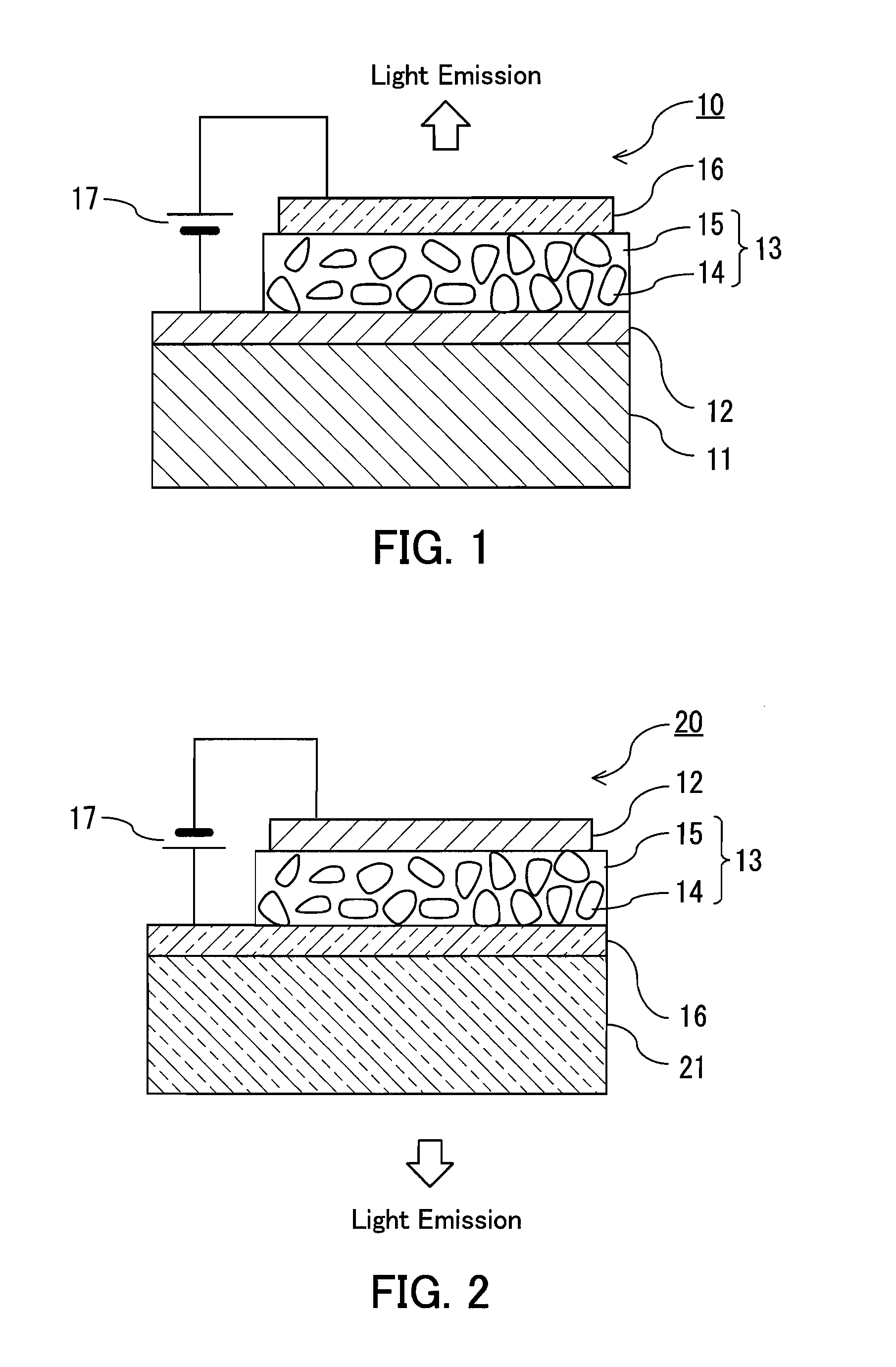Light emitting device having inorganic luminescent particles in inorganic hole transport material
a technology of inorganic luminescent particles and light emitting devices, which is applied in the direction of discharge tubes/lamp details, discharge tubes luminescnet screens, natural mineral layered products, etc., can solve the problems of limited use of el devices, insufficient brightness and efficiency of inorganic el devices using inorganic materials as luminescent materials, and insufficient long-term reliability of el devices for display devices. , to achieve the effect of high brightness, low voltage and high efficiency
- Summary
- Abstract
- Description
- Claims
- Application Information
AI Technical Summary
Benefits of technology
Problems solved by technology
Method used
Image
Examples
example 1
[0061]A light emitting device having the same structure as the light emitting device 10 shown in FIG. 1 was fabricated as a light emitting device of Example 1.
[0062]First, Ga2O3 was allowed to react in an ammonia atmosphere at 1000° C. for 3 hours, thereby preparing GaN particles as luminescent particles. The average particle diameter of the resultant GaN particles was 2 μm.
[0063]Next, the GaN particles thus obtained and a paste containing SiC fine particles (average particle diameter: 5 nm) used as an inorganic hole transport material were kneaded at a volume ratio of 1:1. The paste was a mixture in which the SiC fine particles and a binder (“EL binder” made by Saitama Yakuhin Co. Ltd.) were mixed at the volume ratio of 1:1. The light emitting layer was formed using the kneaded mixture in which the GaN particles were dispersed. Specifically, the light emitting layer was formed by applying the kneaded mixture of the GaN particles and the SiC fine particles on an ITO electrode of a g...
example 2
[0065]A light emitting device of Example 2 having the same structure as the light emitting device 30 shown in FIG. 3 was fabricated.
[0066]First, Ga2O3 was allowed to react in an ammonia atmosphere at 1000° C. for 3 hours, thereby preparing GaN particles as luminescent particles. The average particle diameter of the resultant GaN particles was 2 μm. An ITO nano paste (“X-105” made by SUMITOMO METAL MINING CO., LTD., average particle diameter of ITO fine particles: 50 nm) was used for the conductive fine particles. The ITO nano paste and the GaN particles were kneaded at 1:1 (volume ratio) so that the conductive fine particles made of ITO were adhered to the surfaces of the GaN particles.
[0067]Next, the resultant GaN particles to which the conductive fine particles were adhered and a paste containing, as a main component, SiC fine particles (average particle diameter: 5 nm) used as an inorganic hole transport material were kneaded at a volume ratio of 1:1. The paste was a mixture of t...
example 3
[0068]GaN particles to which the conductive fine particles were adhered were prepared in the same manner as described in Example 2. Next, the GaN particles were dispersed on a surface of a Si substrate except for an electrode pad bonding region. At that time, detachment of the GaN particles from the substrate was prevented using the planarization material (inorganic SOG, “HSG-255” made by Hitachi Chemical Co., Ltd.) that is generally used for forming interlayer dielectric films. Next, Se was evaporated on the resultant GaN particles layer to constitute a matrix portion (inorganic hole transport material) made of a-Se between the GaN particles, thereby forming a light emitting layer. Next, an ITO electrode was formed on the light emitting layer using a sputtering method. Thus, a light emitting device was obtained. When a direct current voltage was applied to the resultant device in the same manner as Example 1 to evaluate its light emission performance, the device emitted light at 11...
PUM
| Property | Measurement | Unit |
|---|---|---|
| particle diameter | aaaaa | aaaaa |
| particle diameter | aaaaa | aaaaa |
| diameter | aaaaa | aaaaa |
Abstract
Description
Claims
Application Information
 Login to View More
Login to View More - R&D
- Intellectual Property
- Life Sciences
- Materials
- Tech Scout
- Unparalleled Data Quality
- Higher Quality Content
- 60% Fewer Hallucinations
Browse by: Latest US Patents, China's latest patents, Technical Efficacy Thesaurus, Application Domain, Technology Topic, Popular Technical Reports.
© 2025 PatSnap. All rights reserved.Legal|Privacy policy|Modern Slavery Act Transparency Statement|Sitemap|About US| Contact US: help@patsnap.com



